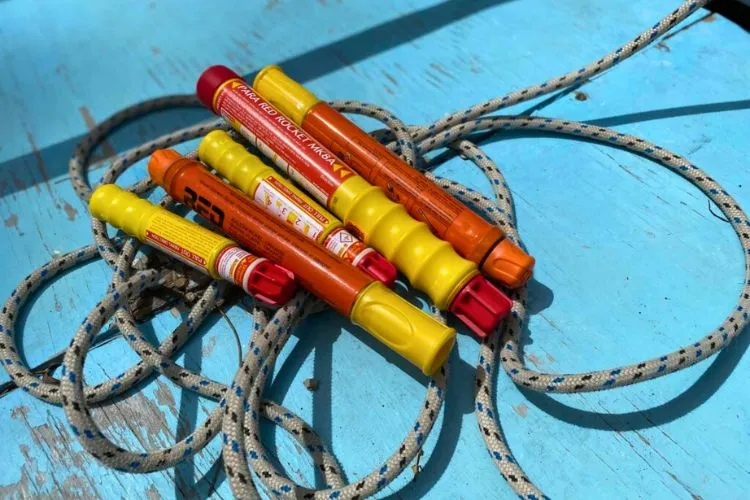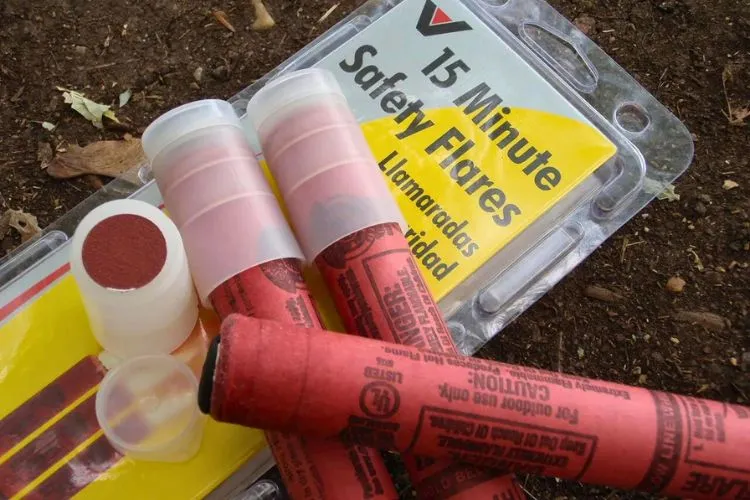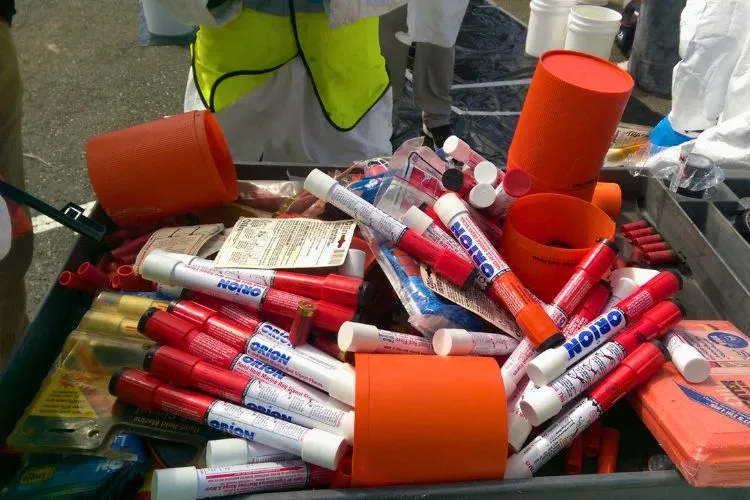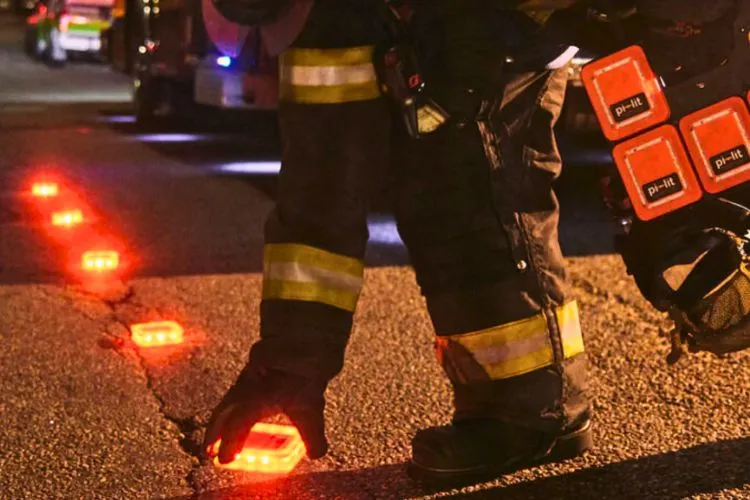Flares are essential tools used in emergencies to signal distress and help ensure safety.
Commonly seen during road mishaps and on the water, these devices serve the critical purpose of conveying danger and location to responders.
But, are flares waterproof?
Well, this is an important question that often comes up around these devices is about their ability to function in wet conditions.
This article will discuss various aspects of flares, particularly their design against water exposure, and will delve into the technicalities of waterproof versus water-resistant flares.

What are Flares Made of?
Flares consist of a combustible substance encased in a shell. The material inside, which lights up brightly when ignited, can be a mixture of oxidizing agents, fuels, colorants, and binders.
The specific composition depends on the intended use, whether for illumination or for creating smoke signals.
Types of Flares and Their Uses
Flares serve multiple roles across different scenarios:
- Maritime Distress Signaling: Here, flares are used to signal one’s position during emergencies at sea.
- Road Safety: For incidences on the road, flares are deployed to warn incoming traffic of potential dangers or obstructions.
Are Flares Waterproof?
Manufacturers of flares adhere to rigorous testing to ensure that these devices can operate in wet conditions. The tests commonly involve exposing flares to both fresh and saltwater environments to simulate real-world scenarios where these devices might be used.
The Difference Between Water-Resistant and Waterproof Flares
It is crucial to distinguish between water-resistant and waterproof flares. Water-resistant flares can handle minor exposure to water, such as light rain or splashes.

Waterproof flares, on the other hand, are designed to function even after full submersion in water. They usually feature a higher degree of sealing and more robust materials to withstand these conditions.
Common Types of Flares and Their Waterproof Status
Marine Flares
Marine flares are typically waterproof as they are specifically designed for use in aquatic environments. They must withstand submersion and still perform effectively, ensuring they can be used to signal for help from the water.
Roadside Flares
- Traditional Combustion Flares: These are often merely water-resistant, as they are generally meant for use on roads and do not require the same level of protection against submersion as marine flares.
- LED Flares: Many LED flares are fully waterproof, offering a durable and reliable alternative to traditional flares for use in various weather conditions.
Safety and Effectiveness
The waterproof nature of flares is not just about functionality but also relates to safety. A flare that fails to perform in wet conditions can result in a lack of proper signaling, which could delay rescue operations and possibly lead to more severe outcomes.
Tips for Storing and Using Flares in Wet Conditions
It is advisable to store flares in a dry, secure location to maintain their effectiveness. When using flares, always ensure that the striking surface is dry and that you have a clear area to deploy the flare safely.
Flare Storage and Maintenance
Proper storage and maintenance of flares are crucial for ensuring they remain effective when needed. Here’s how you can manage this:

Best Practices for Long-Term Storage
To keep flares in optimal condition, they should be stored in a cool, dry place away from direct sunlight and heat sources, as excessive heat can degrade the explosive compounds within.
Flares should be kept in their original packaging to protect against moisture and physical damage. It’s also essential to keep them out of reach of children and in a location where they can be quickly accessed in an emergency.
Checking Expiry Dates
Flares have a shelf life and are usually marked with expiry dates. It’s vital to monitor these dates and replace flares as needed. Expired flares may not ignite reliably, compromising your safety.
Check the dates periodically and note the recommended replacement schedule suggested by the manufacturer. Always handle outdated flares according to local regulations, as improper disposal may pose safety and environmental risks.
Managing flares with these guidelines ensures that your emergency signaling equipment will function as intended when the need arises, providing peace of mind and enhancing safety during critical situations.
Legal and Environmental Considerations
The use of flares is regulated to ensure safety and effectiveness in emergencies. Regulations vary by country and region but typically mandate the types of flares that must be carried in vehicles or on vessels, how they are to be stored, and the proper ways to use them.
For instance, maritime organizations might require specific types of marine flares for boats and ships. Always check local rules and regulations to ensure compliance.
Flares can have significant environmental impacts, including releasing harmful chemicals and residues into the environment. The combustion process in traditional pyrotechnic flares can emit toxic gases and leave behind debris.
Manufacturers are increasingly looking at more environmentally friendly alternatives, such as LED flares, which offer comparable visibility without the environmental toll of chemical flares.
Users are encouraged to dispose of spent or expired flares properly, adhering to local hazardous waste management protocols to minimize ecological damage.
Alternatives to Traditional Flares
Exploring Modern Alternatives: Newer technologies are providing safer and more environmentally friendly options for emergency signaling. Devices like LED flares, electronic beacons, and laser flares are emerging as viable alternatives.
These tools are reusable, eliminating the risks associated with fire and toxic emissions, and they do not expire, making them more sustainable and cost-effective in the long run.

Comparing Effectiveness: When compared to traditional flares, these modern alternatives hold up well in terms of visibility and reliability. LED flares and electronic beacons can match the illumination time and visibility distance of traditional flares but with greater safety.
Laser flares offer precise location signaling over long distances. Their operational advantages, combined with reduced environmental impact, make them compelling choices for emergency preparedness.
Conclusion:
Navigating the details of flare waterproof capabilities is essential for selecting the right type of flare for specific conditions. Whether for use in maritime environments or roadside emergencies, understanding whether a flare is water-resistant or waterproof can significantly impact its effectiveness and safety.
Always consult with manufacturers and adhere to safety guidelines when handling and storing flares.
By recognizing the importance of these features and following best practices for their use, you can ensure that flares will serve their intended purpose reliably when needed.
This exploration into the waterproof characteristics of flares helps clarify their varying capabilities and offers insights on how to best use these critical safety tools.
By understanding these aspects, users can better prepare for emergencies in any conditions.


